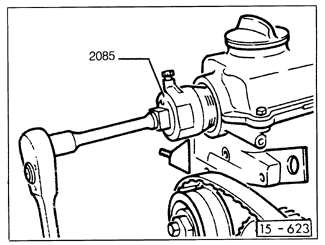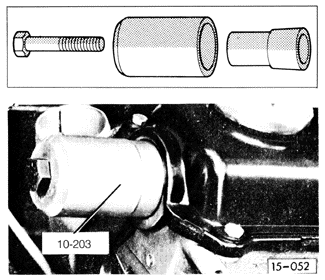4.3 Camshaft Oil Seal
To save disassembly, the camshaft oil seal can be removed using a seal extractor such as Volkswagen special tool no. 2085, shown in Fig. 4-6. The procedure that follows involves more disassembly and does not require special tools.
| Fig. 4-6. | Oil seal extractor being used to remove camshaft oil seal. |

|
To replace camshaft oil seal
| 3. | Remove the camshaft sprocket. Loosen the center sprocket bolt 1/2 turn and, using a soft-faced hammer, tap the sprocket loose. On all except 16-valve engines, take care also to remove the woodruff key from the shaft. |
| 4. | On 16-valve engines only, remove the ignition distributor from the cylinder head, as described in IGNITION. |
CAUTION -
Failure to loosen and tighten the bearing caps in the order prescribed may damage the bearing caps or warp the camshaft.
|
| 6. | Lift slightly on the sprocket end of the camshaft and remove the oil seal. A small screwdriver may help to pry it loose. On 16-valve engines, use care not to disturb the camshaft drive chain at the other end of the cylinder head. |
| 9. | Lightly oil the seal lip and camshaft's sealing surface. Fit the seal into position, and carefully drive it into place until it is flush with the front of the cylinder head. Use care not to distort the seal as it is installed. For best results, use a seal driver such as Volkswagen special tool no. 10-203, shown in Fig. 4-7. |
| 10. | Reinstall the camshaft drive belt sprocket. On 16-valve engines, one side of the integral key is curved. The curved part of the key faces the engine. Torque the sprocket bolt to 65 Nm (48 ft. lb.) on 16-valve engines. On all gasoline engines except 16-valve, torque the sprocket bolt to 80 Nm (59 ft. lb.). On diesel engines, torque the sprocket bolt to 45 Nm (33 ft. lb.). |
| Fig. 4-7. | Camshaft oil seal being installed. Inset shows parts of Volkswagen special tool no. 10-203. |

|
|

